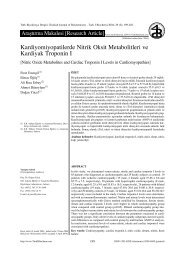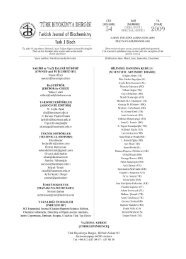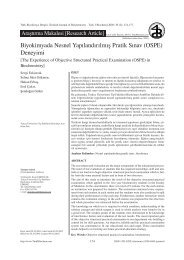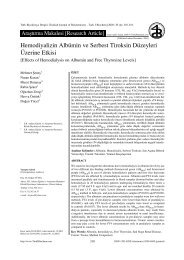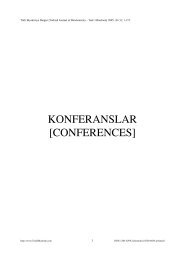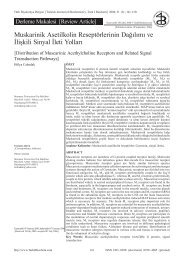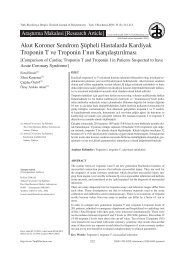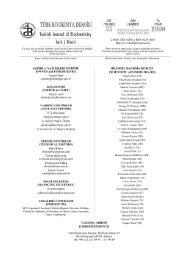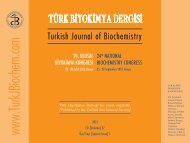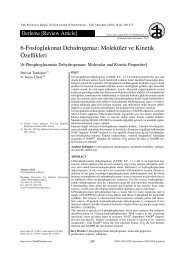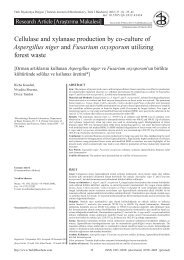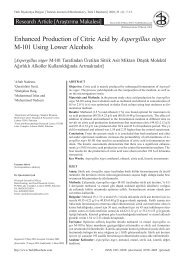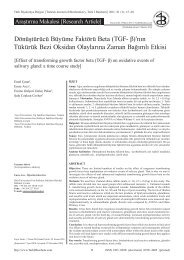23. Ulusal Biyokimya Kongresi Ãzel Sayısı - Türk Biyokimya Dergisi
23. Ulusal Biyokimya Kongresi Ãzel Sayısı - Türk Biyokimya Dergisi
23. Ulusal Biyokimya Kongresi Ãzel Sayısı - Türk Biyokimya Dergisi
Create successful ePaper yourself
Turn your PDF publications into a flip-book with our unique Google optimized e-Paper software.
XXIII. ULUSAL B‹YOK‹MYA KONGRES‹<br />
29 Kasım - 2 Aralık 2011<br />
Hilton Hotel - Adana<br />
<strong>23.</strong> <strong>Ulusal</strong> <strong>Biyokimya</strong> <strong>Kongresi</strong>, Adana [23 rd National Biochemistry Congress, Adana / TURKEY]<br />
İÇİNDEKİLER<br />
DAVETLİ KONUŞMACI ÖZETLERİ<br />
GENEL OLARAK AKIM SİTOMETRİ UYGULAMALARI VE ORGAN<br />
NAKLİNDE YERİ<br />
H Gülçin ESKANDARİ<br />
Mersin Üniversitesi, Tıp Fakültesi, <strong>Biyokimya</strong> Anabilim Dalı, Mersin.<br />
Akım sitometri, hücre ya da partiküller tek sıra halinde ışık kaynağı önünden<br />
geçerken verdikleri sinyaller doğrultusunda belirleyen bir cihazdır. Yöntemin<br />
değeri çok kısa sürede çok sayıda hücre ölçümü yapabilmesindedir. Heterojen hücre<br />
populasyonlarında değişik alt gruplar tanımlanıp, kantitasyonu yapılabilir. Seçilen<br />
hücre populasyonları ileri çalışmalar için fiziksel olarak ayrıştırılabilir. Akım sitometri<br />
klinik rutin laboratuvarlarda hastalıkların tanı, prognoz ve izleminde giderek daha çok<br />
kullanılmaya başlanmıştır. Cihazın en sık kullanım alanını hematolojik neoplazmlarda<br />
immünfenotipleme oluşturmaktadır. Ayrıca transplantasyon laboratuvarlarında da<br />
yıllardır akım sitometri kullanılmaktadır. Alıcıda, donör hücrelerinde eksprese edilen<br />
antijenlere karşı antikorların varlığı erken rejeksiyon ya da graft kaybı açısından<br />
majör bir risk faktörüdür. Bu problemin üstesinden gelmek amacıyla donör hücreleri<br />
ile alıcı serumu arasında “cross-match” yapılmaktadır. “Cross-match”de kullanılan<br />
ilk yöntem, kompleman bağımlı sitotoksisite, göreceli olarak duyarlı olmayan bir<br />
yöntemdir. Akım sitometrik “cross-match” ilk olarak 1982 yılında geliştirilmiş olup,<br />
transplantasyondan önce donör özgül HLA antikorlarının tespiti için önemli bir<br />
yöntemdir. İlk kullanılan teknikten daha duyarlı olma gibi bir avantajı vardır. 2000’li<br />
yılların başlarında akım sitometri ile panel reaktif antikorlar incelenmeye başlanmıştır.<br />
Bu sistemde HLA antijenleri ile kaplı mikro boncuklar HLA antikorlarının hem<br />
sıklığını hem de spesifikliğini saptamak üzere kullanılmaya başlanmıştır.<br />
Anahtar Kelimeler: Akım sitometri, Cross-match, Panel reaktif antikorlar<br />
FLOW CYTOMETRIC APPLICATIONS IN GENERAL AND IT’S ROLE<br />
ON ORGAN TRANSPLANTATION<br />
H Gülçin ESKANDARI<br />
Department of Medical Biochemistry, School of Medicine, Mersin University,<br />
Mersin.<br />
A flow cytometer is an instrument that illuminates cells or other particles as they flow<br />
individually in front of a light source and then detects and correlates the signals from<br />
those cells that result from the illumination. The value of the technique lies in the<br />
ability to make measurements on large numbers of single cells within a short period of<br />
time. The heterogeneity of populations can be revealed and different subsets of cells<br />
identified and quantified. Selected cell populations can also be physically sorted for<br />
further study. Flow cytometry is finding increasing use in routine clinical laboratories<br />
for the diagnosis, prognosis and monitoring of disease. The immunophenotyping<br />
of patients with a haematological neoplasm is the most frequently used area of the<br />
tool. Flow cytometry has also been used in the transplantation laboratory for several<br />
years. The presence of recipient antibodies against antigens expressed on donor cells<br />
are a major risk factor for early rejection or graft loss. To overcome this problem<br />
crossmatching between donor cells and recipient serum is performing. The initial<br />
tecnique for crossmatching, complement-dependent cytotoxicity, is relatively<br />
insensitive. The flow cytometric crossmatch which was developed in 1982, is an<br />
important method to investigate donor specific HLA antibodies before transplantation.<br />
The test has the advantage of being more sensitive than the initial tecnique. Since the<br />
early 2000s, panel reactive antibodies have been investigated by flow cytometry. In<br />
this system micro beads coated with HLA antigens have been used to detect both the<br />
frequency and the specificity of HLA antibodies.<br />
CONTENTS<br />
ABSTRACTS OF INVITED LECTURES<br />
Turk J Biochem, 2011; 36 (S2)<br />
http://www.TurkJBiochem.com



